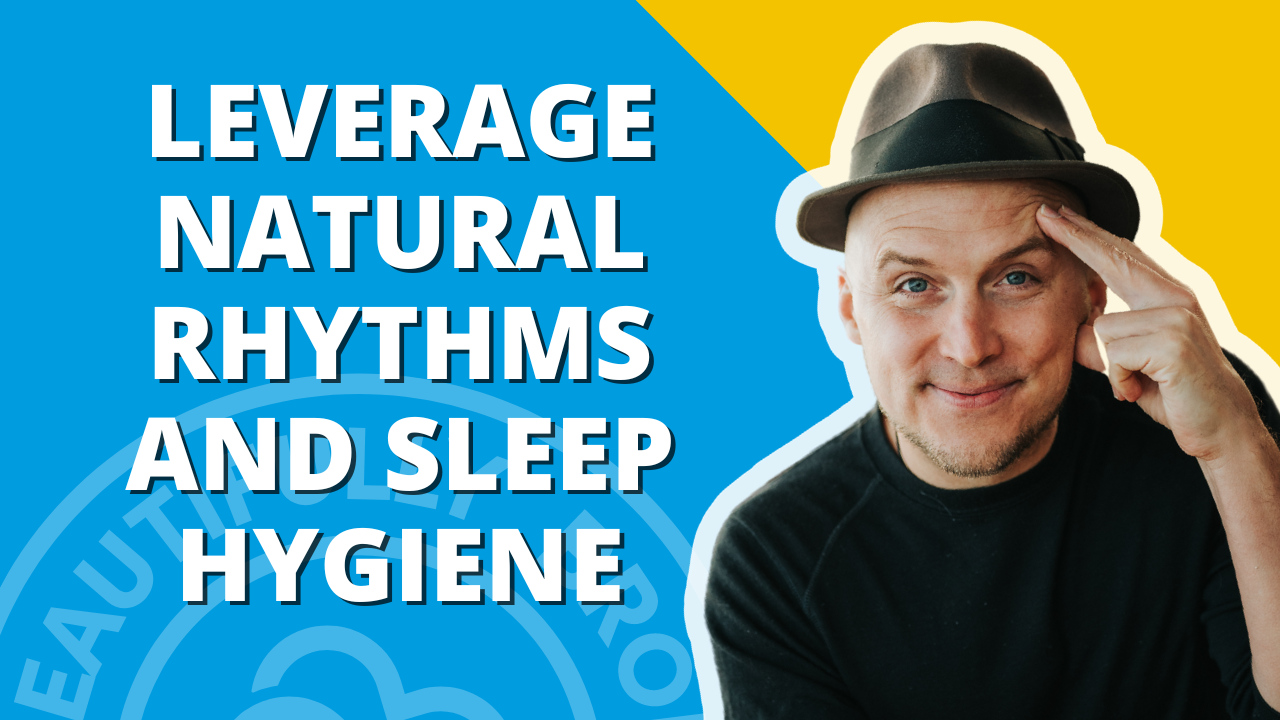Mastering Behavior Change: Harnessing Natural Rhythms and Sleep Hygiene for Success
May 03, 2023
Welcome, beautiful souls, to another episode of the Beautifully Broken Podcast with your host, Freddie Kimmel.
Today, we dive deep into the fascinating world of behavior change and the precious commodity of time. As a famous scientist wisely said, "Just because your pain is understandable, doesn't mean your behavior is acceptable."
So, let's explore how we can protect our time and make conscious choices to align our habits with our natural rhythms for optimal success!
Phase 1: Energize Your Day
As we embark on the journey of behavior change, one practical approach is to divide each 24-hour day-night cycle into three distinct phases: Phase 1, Phase 2, and Phase 3, synchronizing with our brain and body's innate rhythms. [1, 2]
Phase 1 spans from 0-8 hours after waking, and it's the perfect time to set 1-4 habits that require energy and focus. [3, 4, 5]
Personally, I incorporate activities such as gratitude journaling, morning mobility and movement, using a vibration plate in front of the red light panel, getting morning sunlight, and breath activation. I even do 2 rounds with a prolonged breath-hold to kickstart my day with intention and vitality.

Phase 2: Ride the Serotonin Wave
Moving into Phase 2, which encompasses 9-15 hours after waking (for me, that's usually the dreaded afternoon slump from 3-5 pm), our serotonin levels naturally peak while adrenaline lowers. [6, 7]
This makes it an opportune time for habits that do not require overcoming limbic friction, such as creative exploration or lower-focus physical pursuits. [2]
Personally, I indulge in activities such as walking the nature trails, graphic design with Canva, engaging in walk-and-talk conversations, or even singing while bouncing on the trampoline to boost my mood and creativity.

Phase 3: Prioritize Sleep for Reset
As we approach Phase 3, occurring from 16-24 hours after waking, it's crucial to prioritize sleep and follow sleep hygiene practices to reset our ability to overcome limbic friction. This includes avoiding bright lights and screens [8, 9, 10], sleeping in a cool and dark room [11, 12, 13], and considering supplementation if needed.
Taking care of our sleep hygiene can greatly support our ability to tackle habits that may require more effort and focus, setting us up for success in behavior change.
Understanding Limbic Friction
Now, let's take a moment to understand the concept of «limbic friction» itself. [2]
It refers to the energy or effort required to overcome barriers such as anxiety, procrastination, and fatigue that can hinder habit formation or habit change. It's the resistance or friction we may experience in our limbic system, the part of the brain responsible for emotion, motivation, and behavior, when we attempt to establish or modify habits. [14]
Leveraging Natural Rhythms and Sleep Hygiene
Renowned neuroscientist Dr. Andrew Huberman suggests leveraging the natural rhythms of our brain and body during different phases of the day to minimize limbic friction and bring ease to our habit formation journey. [2]
He also emphasizes the importance of sleep hygiene and shares practical tips such as using blue blockers, down-regulating with a sauna, engaging in nighttime journal dumping, and using tools like Biostrap to track our sleep and behavior patterns. Incorporating these practices into our routine can greatly enhance our success in behavior change!
Track and Assess Your Habits
Another effective approach to behavior change is to track our habits for at least 21 days without incorporating new ones. This allows us to assess which habits have become ingrained and are truly serving us.
Breaking a habit requires conscious awareness and intentional effort. One effective strategy is to engage in positive behavior immediately after the habit. [14] For example, taking a break from the phone can be followed by a 30-second handstand or a vocal warm-up session.
We can also use assessment tools such as Journey, a community pod, or a Styku 3D Body Scanner, to gain insights and feedback on our progress. This self-awareness Scanner, to gain insights and feedback on our progress.
I say all this to offer:
Are you able to self-correct and make TRUE changes in your life?
In my experience, this is the MILLION dollar trait that we should be focusing on in our educational systems and cultivating in our friends and family! Give a hand and help someone change an engrained pattern…what is the value of THAT?!
Priceless!
Bonus
🔥 Here you can find product codes with discounts up to $500 for some great biohacking products that can help you implement new habits and sleep well!
- BioStrap (10% off)
- BrainTap (Free 15-day Gift)
- AmpCoil ($99 off)
- BiOptimizers supplements (10% off)
- CellCore Supplements (Free Consultation)
- Dry Farm Wines (Extra bottle for 1 Penny!)
⭐ And here are some amazing Beautifully Broken Podcast Episodes related to this topic:
- #145 Neuro Bioelectric Stimulation and Rapid Healing with Garrett Salpeter (Apple Podcasts | Google Podcasts | Spotify | Youtube)
- #125 The Limbic Brain and Maximizing JOY (Apple Podcasts | Google Podcasts | Stitcher | Spotify)
- #113 The YES and Energy Solution (Apple Podcasts | Google Podcasts | Stitcher | Spotify)
- #98 Breathwork, Biohacking, and Warrior Woman Mode (Apple Podcasts | Google Podcasts | Stitcher | Spotify)
- #46 Gratitude Free Flow (Apple Podcasts | Google Podcasts | Stitcher | Spotify)
- #44 Forgive into Love (Apple Podcasts | Google Podcasts | Stitcher | Spotify)
- #32 The Fasting Mimicking Diet, Deep Sleep, and the Copilot Experience with Laura McKowen (Apple Podcasts | Google Podcasts | Stitcher | Spotify)
- #24 The Busy Bee Syndrome-Taking control of your time (Apple Podcasts | Google Podcasts | Stitcher | Spotify)
References
1 Kerkhof G. A. (1985). Inter-individual differences in the human circadian system: a review. Biological psychology, 20(2), 83–112. https://doi.org/10.1016/0301-0511(85)90019-5
2 Build or Break Habits Using Science-Based Tools | Huberman Lab. https://hubermanlab.com/build-or-break-habits-using-science-based-tools/
3 Choi, K., Shin, C., Kim, T. et al. Awakening effects of blue-enriched morning light exposure on university students’ physiological and subjective responses. Sci Rep 9, 345 (2019). https://doi.org/10.1038/s41598-018-36791-5
4 Vandewalle, G., Archer, S. N., Wuillaume, C., Balteau, E., Degueldre, C., Luxen, A., Dijk, D. J., & Maquet, P. (2011). Effects of light on cognitive brain responses depend on circadian phase and sleep homeostasis. Journal of biological rhythms, 26(3), 249–259. https://doi.org/10.1177/0748730411401736
5 Schmidt, C., Collette, F., Cajochen, C., & Peigneux, P. (2007). A time to think: circadian rhythms in human cognition. Cognitive neuropsychology, 24(7), 755–789. https://doi.org/10.1080/02643290701754158
6 Monti, J. M., & Jantos, H. (2008). The roles of dopamine and serotonin, and of their receptors, in regulating sleep and waking. Progress in brain research, 172, 625–646. https://doi.org/10.1016/S0079-6123(08)00929-1
7 Boivin, D. B., Czeisler, C. A., Dijk, D. J., Duffy, J. F., Folkard, S., Minors, D. S., Totterdell, P., & Waterhouse, J. M. (1997). Complex interaction of the sleep-wake cycle and circadian phase modulates mood in healthy subjects. Archives of general psychiatry, 54(2), 145–152. https://doi.org/10.1001/archpsyc.1997.01830140055010
8 Campbell, S. S., Dawson, D., & Anderson, M. W. (1993). Alleviation of sleep maintenance insomnia with timed exposure to bright light. Journal of the American Geriatrics Society, 41(8), 829–836. https://doi.org/10.1111/j.1532-5415.1993.tb06179.x
9 Higuchi, S., Motohashi, Y., Liu, Y., & Maeda, A. (2005). Effects of playing a computer game using a bright display on presleep physiological variables, sleep latency, slow wave sleep and REM sleep. Journal of sleep research, 14(3), 267–273. https://doi.org/10.1111/j.1365-2869.2005.00463.x
10 Gooley, J. J., Chamberlain, K., Smith, K. A., Khalsa, S. B., Rajaratnam, S. M., Van Reen, E., Zeitzer, J. M., Czeisler, C. A., & Lockley, S. W. (2011). Exposure to room light before bedtime suppresses melatonin onset and shortens melatonin duration in humans. The Journal of clinical endocrinology and metabolism, 96(3), E463–E472. https://doi.org/10.1210/jc.2010-2098
11 Libert, J. P., Bach, V., Johnson, L. C., Ehrhart, J., Wittersheim, G., & Keller, D. (1991). Relative and combined effects of heat and noise exposure on sleep in humans. Sleep, 14(1), 24–31. https://doi.org/10.1093/sleep/14.1.24
12 Di Nisi, J., Ehrhart, J., Galeou, M., & Libert, J. P. (1989). Influence of repeated passive body heating on subsequent night sleep in humans. European journal of applied physiology and occupational physiology, 59(1-2), 138–145. https://doi.org/10.1007/BF02396592
13 Mason, I. C., Grimaldi, D., Reid, K. J., Warlick, C. D., Malkani, R. G., Abbott, S. M., & Zee, P. C. (2022). Light exposure during sleep impairs cardiometabolic function. Proceedings of the National Academy of Sciences of the United States of America, 119(12), e2113290119. https://doi.org/10.1073/pnas.2113290119
14 The Psychology of Habit: Theory, Mechanisms, Change, and Contexts. Editors: Bas Verplanken. 2018. ISBN 978-3-319-97529-0. https://link.springer.com/book/10.1007/978-3-319-97529-0




